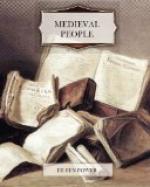Let us now praise famous
men and our fathers that begat us.
The Lord hath wrought
great glory by them through His great
power from the beginning...
Rich men furnished with ability, living peaceably in their habitations: All these were honoured in their generations and were the glory of their times.
Notes and Sources
* * * * *
CHAPTER II
THE PEASANT BODO
A. Raw Material
1. The Roll of the Abbot Irminon, an estate book of the Abbey of St Germain des Pres, near Paris, written between 811 and 826. See Polyptyque de l’Abbaye de Saint-Germain des Pres, pub. Auguste Longnon, t. I, Introduction; t. II, Texte (Soc. de l’Hist. de Paris, 1886-95).
2. Charlemagne’s capitulary, De Villis, instructions to his stewards on the management of his estates. See Guerard, Explication du Capitulaire ’de Villis’ (Acad. des Inscriptions et Belles-Lettres, Memoires, t. XXI, 1857), pp. 165-309, containing the text, with a detailed commentary and a translation into French.
3. Early Lives of Charlemagne, ed. A.J. Grant (King’s Classics, 1907). Contains the lives by Einhard and the Monk of St Gall, on which see Halphen, cited below.
4. Various pieces of information about social life may be gleaned from the decrees of Church Councils, Old High German and Anglo-Saxon charms and poems, and Aelfric’s Colloquium, extracts from which are translated in Bell’s Eng. Hist. Source Books, The Welding of the Race, 449-1066, ed. J.E.W. Wallis (1913). For a general sketch of the period see Lavisse Hist. de France, t. II, and for an elaborate critical study of certain aspects of Charlemagne’s reign (including the Polyptychum) see Halphen, Etudes critiques sur l’Histoire de Charlemagne (1921); also A. Dopsch, Wirtschaftsentwicklung der Karolingerzeit, Vornehmlich in Deutschland, 2 vols. (Weimar, 1912-13), which Halphen criticizes.
B. Notes to the Text
1. ’Habet Bodo colonus et uxor ejus colona, nomine Ermentrudis, homines sancti Germani, habent secum infantes III. Tenet mansum ingenuilem I, habentem de terre arabili bunuaria VIII et antsingas II, de vinea aripennos II, de prato aripennos VII. Solvit ad hostem de argento solidos II, de vino in pascione modios II; ad tertium annum sundolas C; de sepe perticas III. Arat ad hibernaticum perticas III, ad tramisem perticas II. In unaquaque ebdomada corvadas II, manuoperam I. Pullos III, ova XV; et caropera ibi injungitur. Et habet medietatem de farinarium, inde solvit de argento solidos II.’ Op. cit., II, p. 78. ’Bodo a colonus and his wife Ermentrude a colona, tenants of Saint-Germain, have with them three children. He holds one free manse, containing eight bunuaria




